WATER SOURCES AND USE
The National Water Initiative (NWI) addresses water management issues and provides a strategic, coordinated approach to managing connected water systems. The NWI is a commitment by all state and territory governments and the Australian Government through the Council Of Australian Governments (COAG). It maps out Australia’s water management objectives and the basis on which freshwater resources are to be shared to support viable communities, healthy freshwater ecosystems and economic development. Victoria has completed 3 out of 4 water strategies for the designated geographic regions of the state, with assessment of current resources, likelihood of future availability and strategies to maintain reliable water supplies (NWC 2011).
The supply and consumption of domestic water in Victorian households has been influenced by Australia's drought from 1997 to 2010, leading to water restrictions and efforts to improve household water efficiency.
The Victorian government has encouraged water efficiency by providing financial assistance for rainwater tanks connected to toilets and/or laundries, permanent greywater systems, household water audits and other water saving strategies (DSE 2012). As the average family use around half their water in the bathroom and 22 per cent in the laundry , rainwater tanks plumbed into dwellings and greywater systems for the home are particularly useful for saving water. Gardens use 19% of household water and efficient irrigation watering systems can also reduce demand on the mains/town water supply (DSE 2011a).
Another state government initiative was the Water Smart Behaviour Change Program to help people achieve their goals to reduce water use in their homes. Around 100,000 households in Melbourne and 10,000 from Ballarat, Bendigo and Geelong were invited to participate. Of these, over 20,000 households joined the program, receiving advice and ideas for using water more efficiently at home (DSE 2011b).
This chapter examines the use and management of rainwater tanks, grey/recycled water, irrigation watering systems, gardens and swimming pools.
MAINS / TOWN WATER
In Victoria, 94% of households (2,026,400) were connected to mains/town water. Melbourne had 1,533,100 households connected (99%) and Balance of Victoria had 493,300 connections (82%) (Figure 3.1).
In 2011, the lowest rate of mains/town water connection in Melbourne was 95% in the South Eastern Melbourne Statistical Region (SR) and in Balance of Victoria, Loddon Mallee SR had the lowest connection rate (73%).
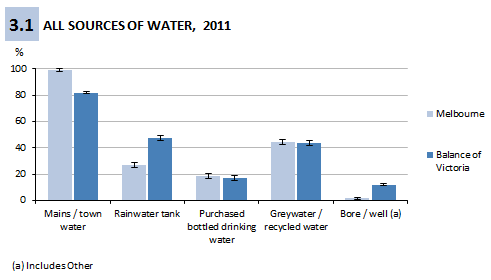
RAINWATER TANKS
There were 706,900 households with rainwater tanks in Victoria. In Balance of Victoria, 48% of households had a rainwater tank and in Melbourne 27% of households had a rainwater tank (figure 3.2). In 2009, 46% of households in Balance of Victoria and 22% of households in Melbourne had rainwater tanks.
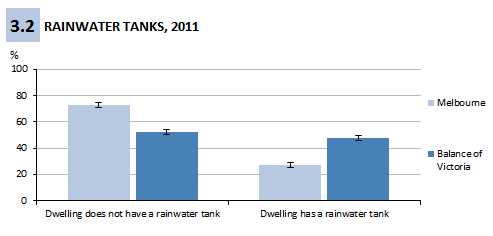
The highest proportion of rainwater tanks in Melbourne was in the Mornington Peninsula SR with 40% (50,600) and in Balance of Victoria the highest proportion was in the Loddon Mallee SR with 64% (68,800) (Figure 3.3).
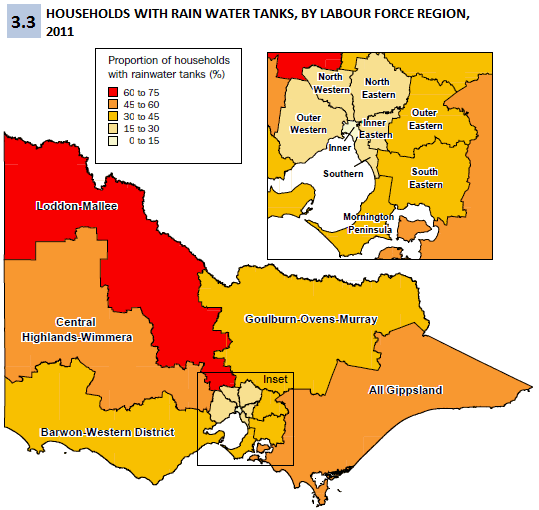
Rainwater tanks in Melbourne were more prevalent in properties owned outright 38% (194,300) or being paid off 32% (184,100) when compared with rented dwellings 8% (32,600). The rate of rainwater tanks installed in Melbourne's separate dwellings 33% (379,100) was more than double that of semi-detached, terrace or townhouses 16% (22,800). In Balance of Victoria, rainwater tanks were more likely to be located in properties owned outright 139,000 (58%) or being paid off 111,700 (52%) rather than rented 27,100 (21%).
In Melbourne, 127,600 households (8%) with rainwater tanks had these plumbed into the dwelling, compared to 164,800 (27%) in Balance of Victoria (Figure 3.4).
Across Victoria, 99,500 (34%) dwellings that had a rainwater tank plumbed into the dwelling also had an irrigation watering system.
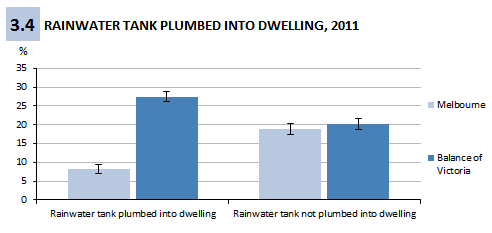
GREY/RECYCLED WATER
In Melbourne 685,900 (44%) households and in Balance of Victoria 263,300 (44%) households used grey/recycled water.
Across Victoria, 38% or more of households in all areas used grey/recycled water except for the Inner Melbourne SR, where 28% used grey/recycled water. Inner Eastern Melbourne SR had the highest overall usage rate with 52% of households using grey/recycled water and in Balance of Victoria Loddon Mallee SR's usage rate was the highest with 49%.
Grey/recycled water use was more prominent in Melbourne households that were owned outright (53%) or being paid off (50%) compared with rented properties (25%). In Melbourne, separate houses (51%) were more likely to use grey/recycled water than semi detached, row, terrace or townhouses (39%) or flats, units and apartments (21%). Melbourne dwellings more than 2 years old had more than twice the proportion of grey/recycled water use (45%) than those 2 years old or less (20%) .
In Balance of Victoria, grey/recycled water use was more likely in dwellings that were owned outright (50%) or being paid off (48%) compared with rented properties (26%).
GARDENS
There were 1,312,500 households with gardens in Melbourne (85%) and 540,900 in Balance of Victoria (90%).
Households in Melbourne's Outer Eastern SR had the highest percentage of gardens in the Melbourne area (93%) and Inner Melbourne SR had the lowest (53%). In Balance of Victoria, both Loddon Mallee SR and All Gippsland SR had the highest percentage of gardens (92%) and Central Highlands-Wimmera SR had the lowest (87%).
IRRIGATION WATERING SYSTEMS
In Melbourne, 21% of households had irrigation watering systems compared to 25% of households in Balance of Victoria (Figure 3.5).


| 
|
The highest percentages of households with an irrigation watering system in Melbourne were in Southern Melbourne SR (30% or 53,900) and the Mornington Peninsula SR (30% or 37,400) while the lowest was in Inner Melbourne SR (13% or17,800) (Figure 3.6).
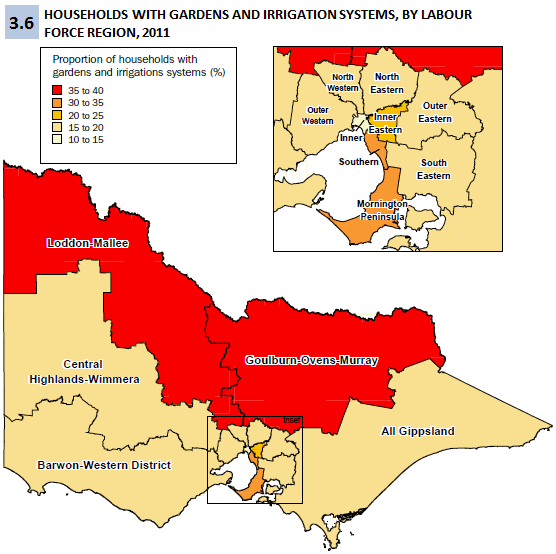
Over a third of Victorian households (34%) with an irrigation watering system also had a rainwater tank. For households with a garden and an irrigation watering system, 32% in Balance of Victoria and 26% in Melbourne also used grey/recycled water.
SWIMMING POOLS
There were 140,700 (7%) Victorian households with a swimming pool and 52,300 (37%) of these households used mains/town water to fill or top up the swimming pool.
In households with a pool, 37% used a dam/rainwater tank to top up the swimming pool. In households with a pool and a rainwater tank 67% used a dam/rainwater tank to top up the pool, while 20% used mains/town water.
Across Victoria, 26% of households with a swimming pool relied on rainfall to fill or top up the pool and 4% of households transported water in to fill or top up the pool (Figure 3.7).
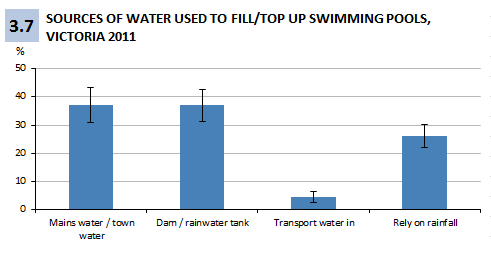
Over a third (36%) of Victorian households with a swimming pool filtered their pool three to five hours per day, and under a third (29%) filtered their pool two hours or less per day. Over one in ten (14%) did not filter their pool daily (Figure 3.8).
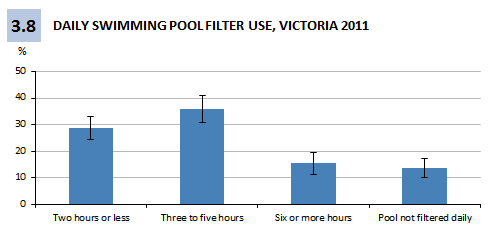
 Print Page
Print Page
 Print All
Print All